FPV BEGINNER GUIDE 2024
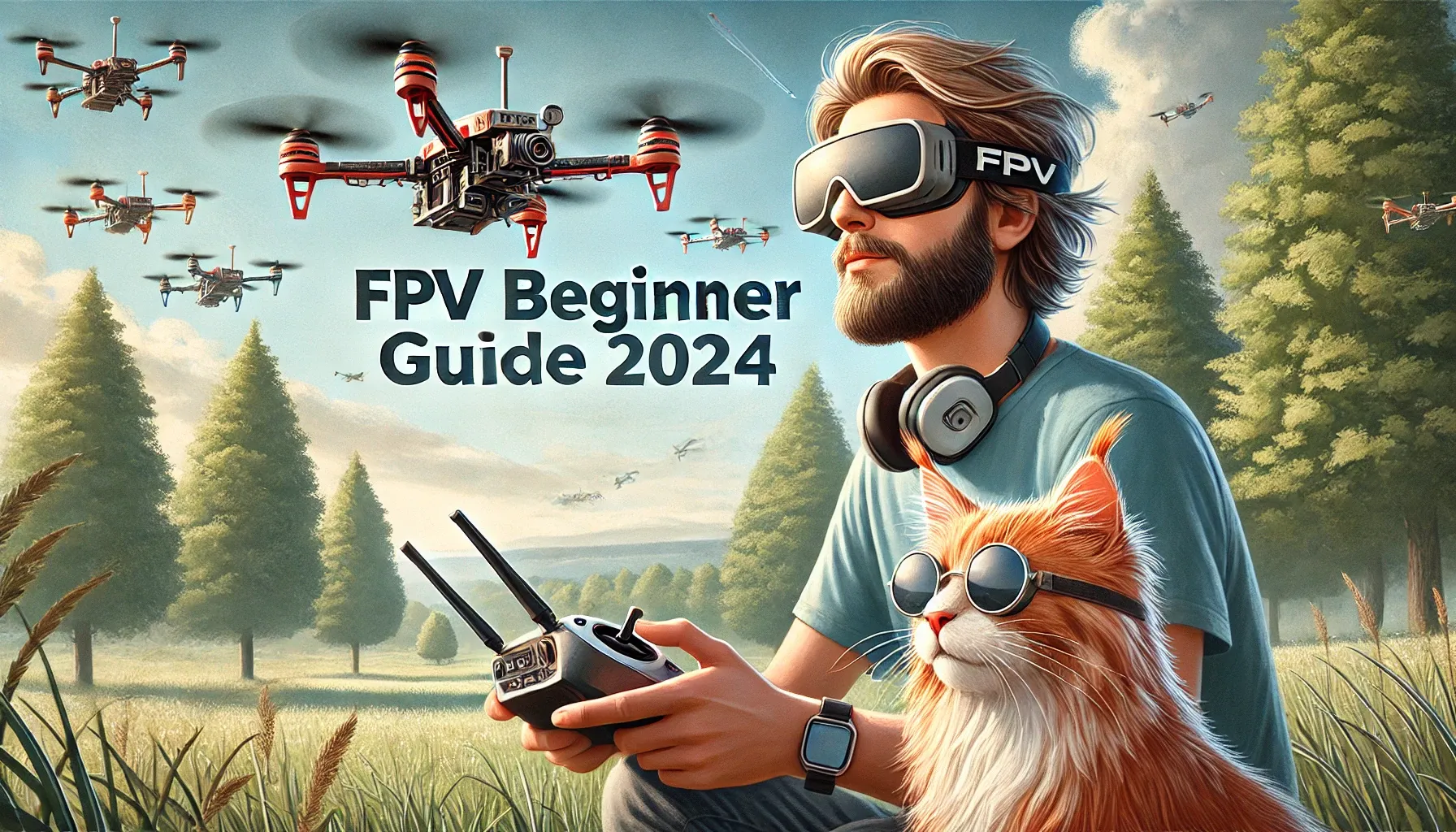
FPV Beginner Guide 2024
Table of Contents
- What is an FPV Drone?
- How FPV Drones Differ from Regular Drones
- Main Components of an FPV Drone
- How FPV Drones are Controlled
- FPV Video Transmission Systems
- Sizes of FPV Drones
- Ready-to-Fly (RTF) Kits for Beginners
- Batteries for Drones: 1S to 6S
- Action Cameras Commonly Used with FPV Drones
- Learning to Fly FPV Drones
- How to Tune FPV Drone
- Conclusion
- FAQ
What is an FPV Drone?
An FPV (First Person View) drone is an unmanned aerial vehicle that provides a live video feed from an onboard camera directly to the pilot’s goggles or screen. This immersive setup makes the pilot feel as if they are inside the drone, offering a thrilling first-person perspective during flight. FPV drones are commonly used for racing, freestyle flying, and capturing dynamic cinematic footage.
How FPV Drones Differ from Regular Drones
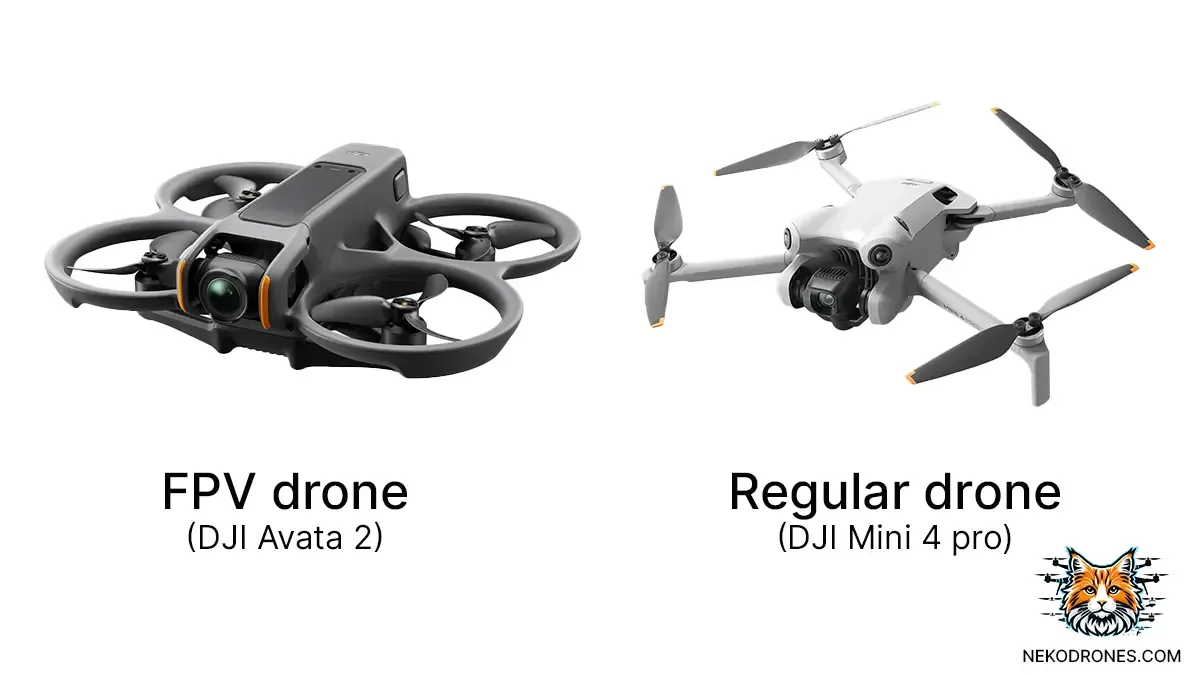 FPV Drones: Primarily designed for racing, freestyle aerobatics, and capturing unique cinematic shots. They cater to hobbyists and professional pilots who enjoy manual control and the excitement of high-speed flight.
FPV Drones: Primarily designed for racing, freestyle aerobatics, and capturing unique cinematic shots. They cater to hobbyists and professional pilots who enjoy manual control and the excitement of high-speed flight.
Regular Drones: Typically used for aerial photography, videography, and general recreational flying. These drones are designed to be user-friendly, often featuring automated flight modes and GPS stabilization.
Main Components of an FPV Drone
Frame
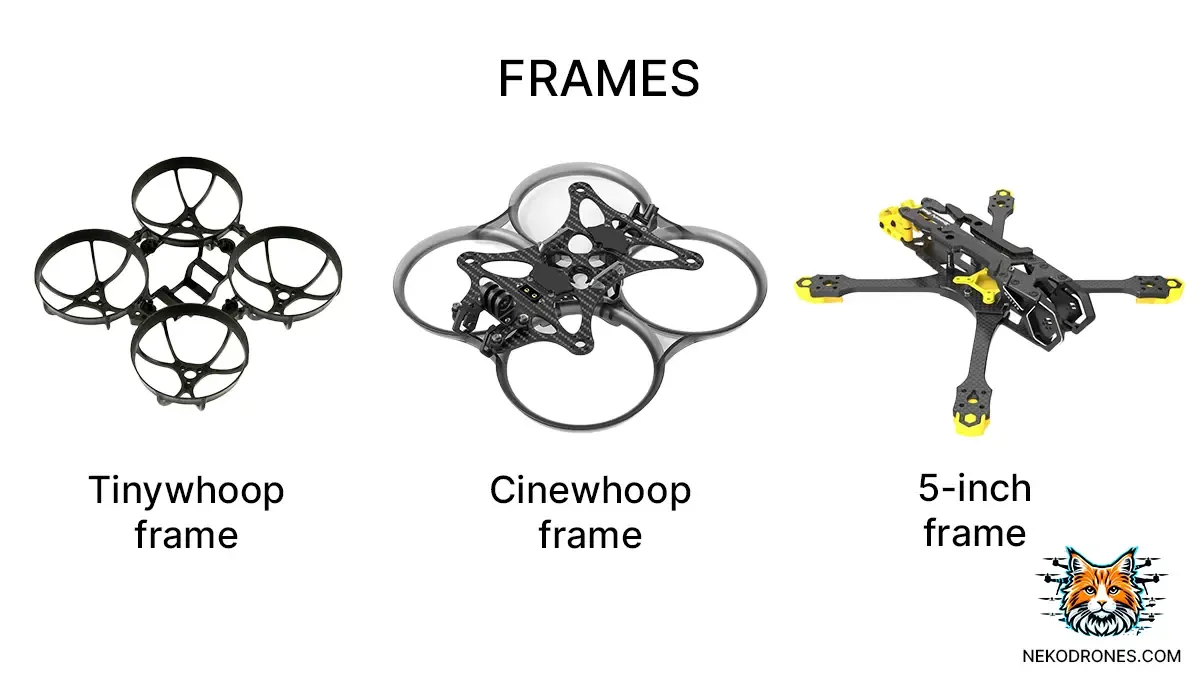
- Function: The frame is the skeleton of the drone that holds all the components together. It provides the structure and shape of the drone.
- Materials: Commonly made from carbon fiber due to its strength and light weight. Frames come in various sizes to fit different types of drones, such as micro, mini, and racing drones.
Motors
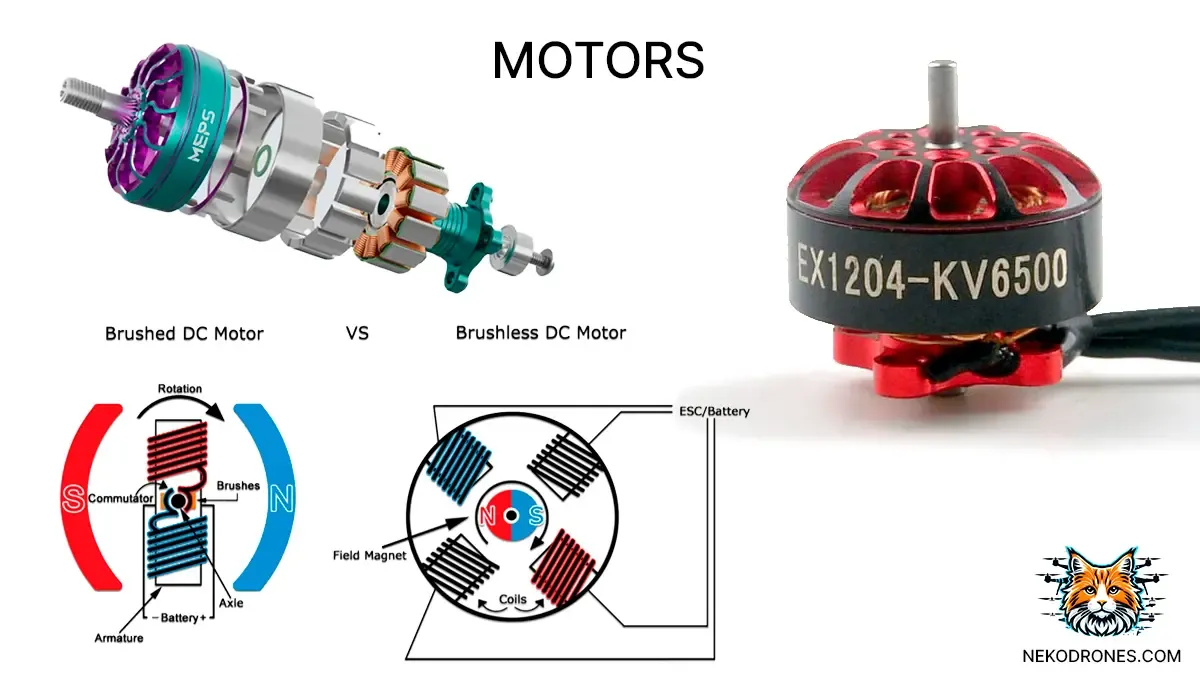
- Function: Motors provide the thrust needed to lift and maneuver the drone. They spin the propellers at high speeds.
- Types: Brushless motors are preferred in FPV drones for their efficiency, power, and durability compared to brushed motors.
- Configuration: Usually, FPV drones have four motors (quadcopters), but there are also hexacopters (six motors) and octocopters (eight motors).
Electronic Speed Controllers (ESCs)
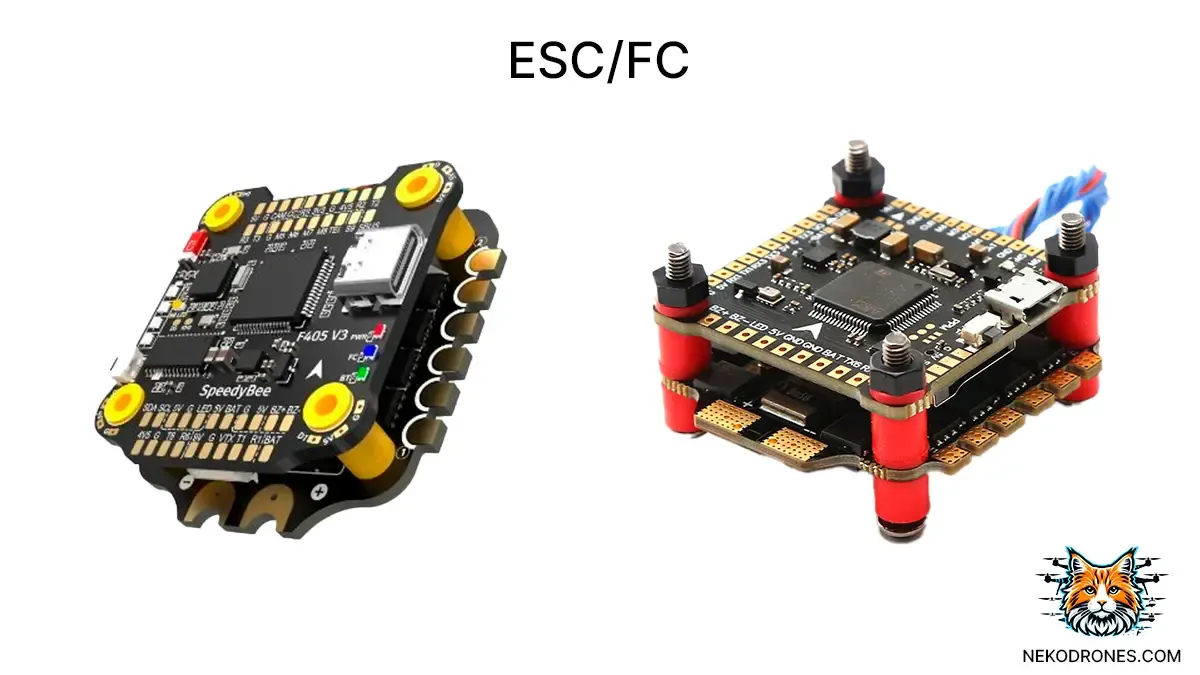
- Function: ESCs regulate the power to the motors based on signals from the flight controller, controlling the speed and direction of each motor.
- Types: Individual ESCs (one per motor) or 4-in-1 ESCs (combining four ESCs into a single board for simplicity and reduced wiring).
Flight Controller
- Function: The flight controller is the brain of the drone. It interprets the pilot's inputs from the transmitter and sends appropriate commands to the ESCs to control the drone’s movement.
- Features: Includes sensors like gyroscopes and accelerometers for stabilization, and sometimes GPS modules for additional functionality.
FPV Cameras
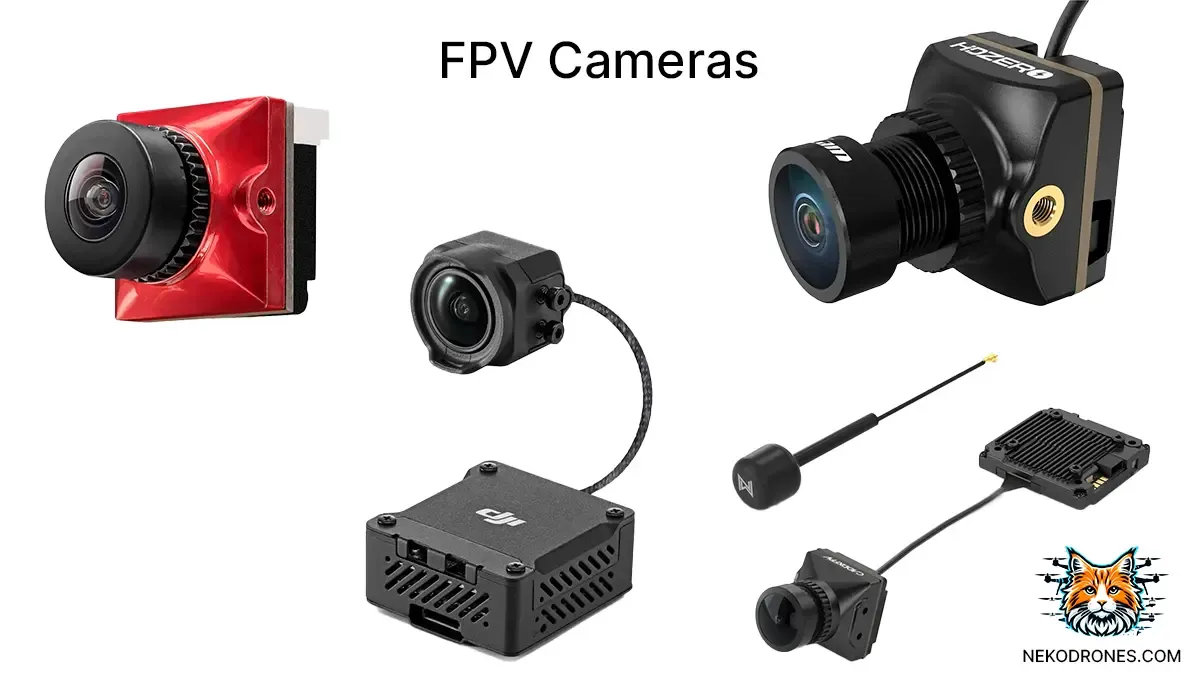
- Function: The FPV camera captures real-time video from the drone’s perspective, allowing the pilot to see where the drone is flying.
- Types: Various options are available, ranging from basic analog cameras to high-definition digital cameras.
Video Transmitter (VTX)
- Function: The VTX transmits the live video feed from the FPV camera to the pilot's goggles or monitor.
- Frequency: Commonly operates on the 5.8GHz frequency band. Power output and antenna type can affect range and video quality.
Antenna
- Function: Both the VTX and the FPV goggles/monitor need antennas to send and receive video signals. The choice of antenna affects the range and clarity of the video feed.
- Types: Linear and circular polarized antennas. Circular polarized antennas are preferred for their better signal reception in most FPV applications.
Propellers
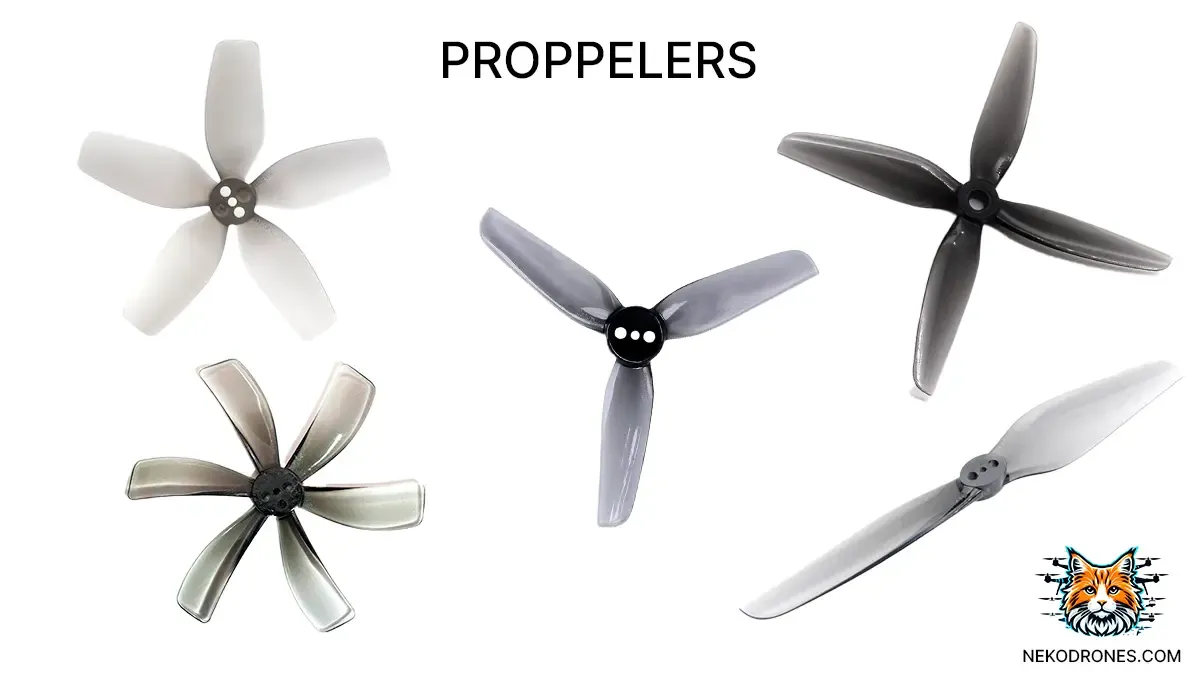
- Function: Propellers generate lift by spinning and pushing air downwards. The size and pitch of the propellers influence the drone's speed, agility, and efficiency.
- Material: Usually made from plastic or composite materials for a balance of durability and performance.
Battery
- Function: The battery powers the entire drone, including the motors, flight controller, and VTX.
- Types: Lithium Polymer (LiPo) batteries are commonly used due to their high energy density and discharge rates. The number of cells (1S to 6S) affects the voltage and power output.
Receiver
- Function: The receiver picks up signals from the pilot’s transmitter and sends them to the flight controller.
- Compatibility: Must be compatible with the transmitter protocol (e.g., FrSky, Spektrum, Crossfire, ELRS).
How FPV Drones are Controlled
Transmitter (Radio controller)
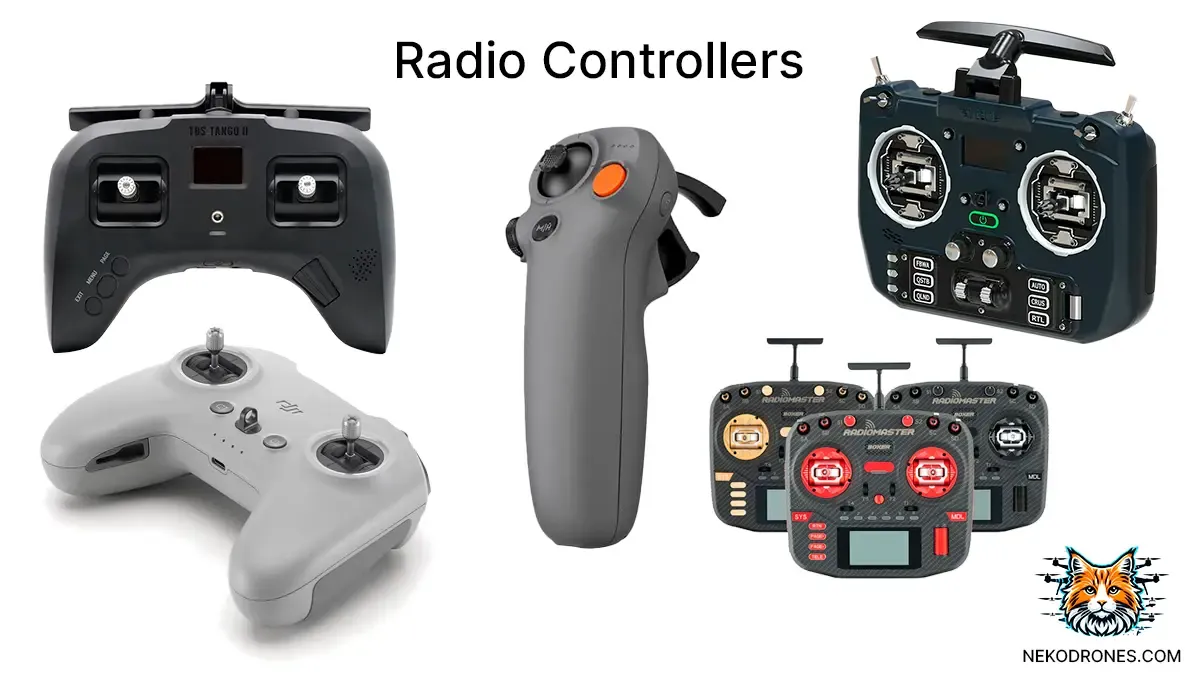 The handheld device used by the pilot to send commands to the drone. It typically includes two joysticks and several switches or buttons.
The handheld device used by the pilot to send commands to the drone. It typically includes two joysticks and several switches or buttons.
- Left Joystick: Usually controls throttle (up/down) and yaw (rotate left/right).
- Right Joystick: Controls pitch (tilt forward/backward) and roll (tilt left/right).
FPV Goggles or Screen
Displays the real-time video feed from the drone’s camera, providing the pilot with a first-person view for immersive flying.
Flight Modes
FPV drones can operate in various flight modes, each offering different levels of control and stability:
- Angle Mode (Stabilized): The drone self-levels when the sticks are centered, making it easier for beginners to fly.
- Horizon Mode: Similar to angle mode but allows for mild acrobatic maneuvers while still providing self-leveling.
- Acro Mode (Rate Mode): Offers full manual control with no self-leveling, allowing for advanced aerobatics and precise maneuvers. This mode is preferred by experienced pilots.
FPV Video Transmission Systems
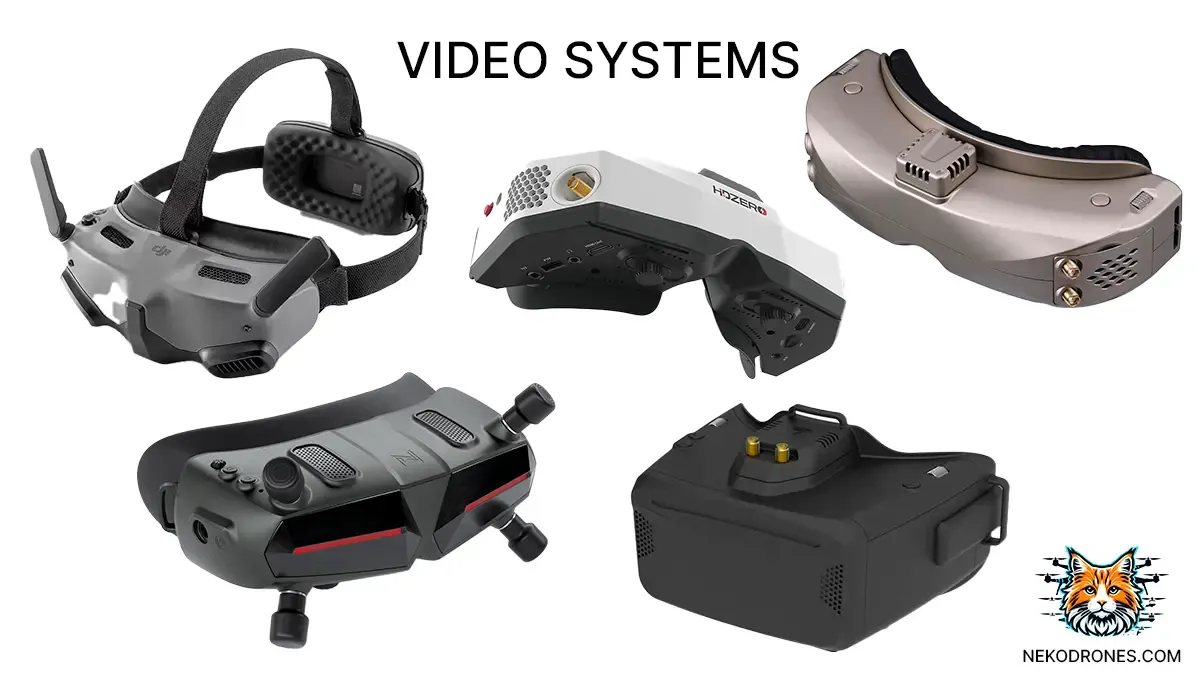
Digital Systems
DJI FPV System
- Video Quality: High-definition video quality, offering resolutions up to 4k at 100fps.
- Range and Latency: Reliable connection with low latency (typically around 28ms), suitable for both freestyle and racing. The range can extend up to several kilometers under optimal conditions.
- User Experience: User-friendly with plug-and-play functionality. Features integrated OSD (On-Screen Display) for telemetry data.
- Price: Generally more expensive than analog systems, reflecting its advanced technology and superior performance.
Walksnail FPV System
- Video Quality: High-definition video quality, competing closely with DJI.
- Range and Latency: Designed for low latency and good range, making them suitable for a variety of flying styles.
- Features: Includes customizable OSD, and compatibility with various goggles and receivers.
- Price: Slightly more affordable than DJI, providing a good balance of performance and cost.
Analog Systems
Traditional Analog FPV
- Video Quality: Standard-definition video, less clear compared to digital systems.
- Range and Latency: Extremely low latency, making them ideal for racing and freestyle flying. Range can vary but is generally sufficient for most FPV activities.
- Durability and Simplicity: Robust and simple to set up, widely used due to their reliability and affordability.
- Price: Much cheaper than digital systems, making them accessible for beginners and hobbyists.
HDZero
- Video Quality: Provides a middle ground between traditional analog and high-end digital systems, offering HD video quality.
- Range and Latency: Boasts low latency and decent range, suitable for both racing and freestyle.
- Features: Includes HD recording, customizable OSD, and compatibility with various goggles.
- Price: Positioned between analog and premium digital systems.
Sizes of FPV Drones
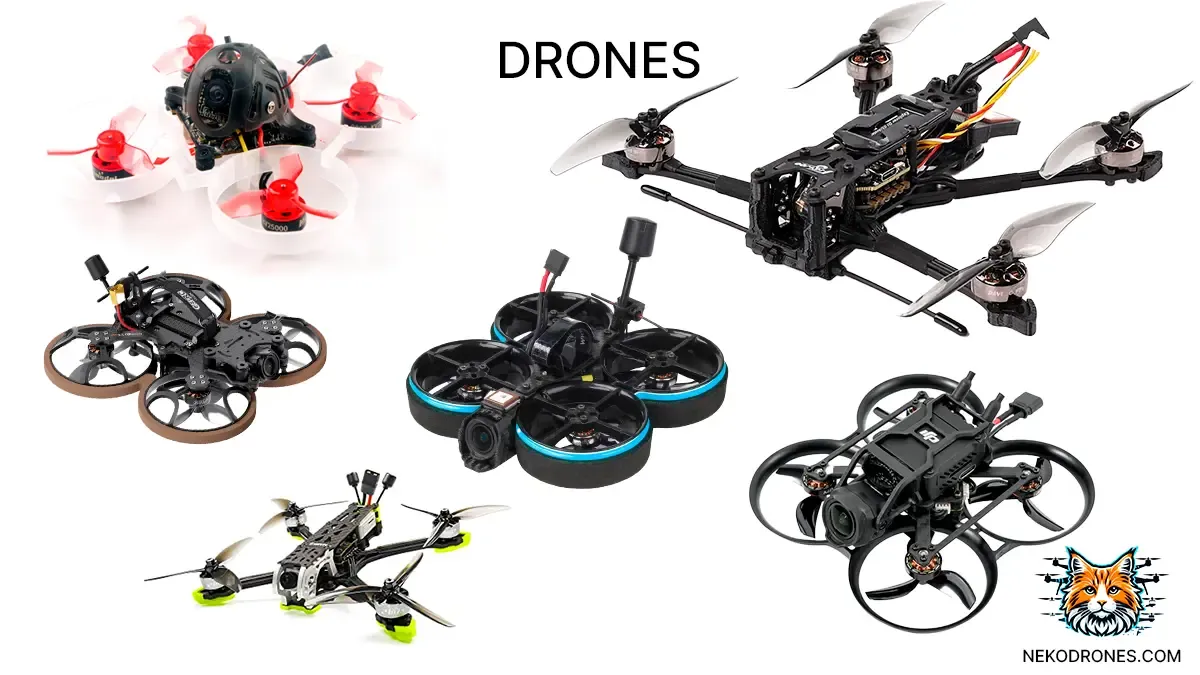
Tinywhoop
- Size: Typically under 100mm motor-to-motor distance.
- Weight: Generally very light, often under 50 grams without the battery.
- Use Case: Ideal for indoor flying, tight spaces, and learning to fly.
- Characteristics: Agile and can perform quick maneuvers, but affected by wind more than larger drones.
Cinewhoop (1.6, 2, 2.5, 3, 3.5 inches)
- Size: Varies between 1.6 inches to 3.5 inches propeller size.
- Weight: Typically lightweight, designed to carry small cameras like GoPro Bones or Insta360 GO.
- Use Case: Perfect for capturing smooth cinematic footage in tight spaces and indoor environments.
- Characteristics: Equipped with ducted fans for safer indoor flying, provides stable and smooth footage.
4-Inch Long Range
- Size: Typically around 4 inches propeller size.
- Weight: Lightweight but built for longer range and flight times.
- Use Case: Ideal for long-range flying and exploration.
- Characteristics: Balanced for endurance and efficiency, capable of flying longer distances compared to smaller drones.
5-Inch Freestyle
- Size: Typically around 5 inches propeller size.
- Weight: Heavier, built for agility and performance.
- Use Case: Popular for freestyle flying and racing, known for their high performance and maneuverability.
- Characteristics: Powerful brushless motors, capable of carrying HD cameras, robust for acrobatic maneuvers and high-speed flights.
Medium Drones
- Size: Typically between 6 inches to 7 inches propeller size.
- Weight: Generally heavier, from 500 grams to 1 kilogram or more.
- Use Case: Used for more serious aerial photography, videography, and long-range FPV flying.
- Characteristics: More stable and capable of longer flight times. Less affected by wind.
Large Drones
- Size: Over 7 inches propeller size.
- Weight: Can weigh several kilograms.
- Use Case: Used for professional applications such as high-end cinematography and industrial inspections.
- Characteristics: Extremely stable with advanced flight control systems. Can carry heavy payloads and have extended flight times.
Ready-to-Fly (RTF) Kits for Beginners
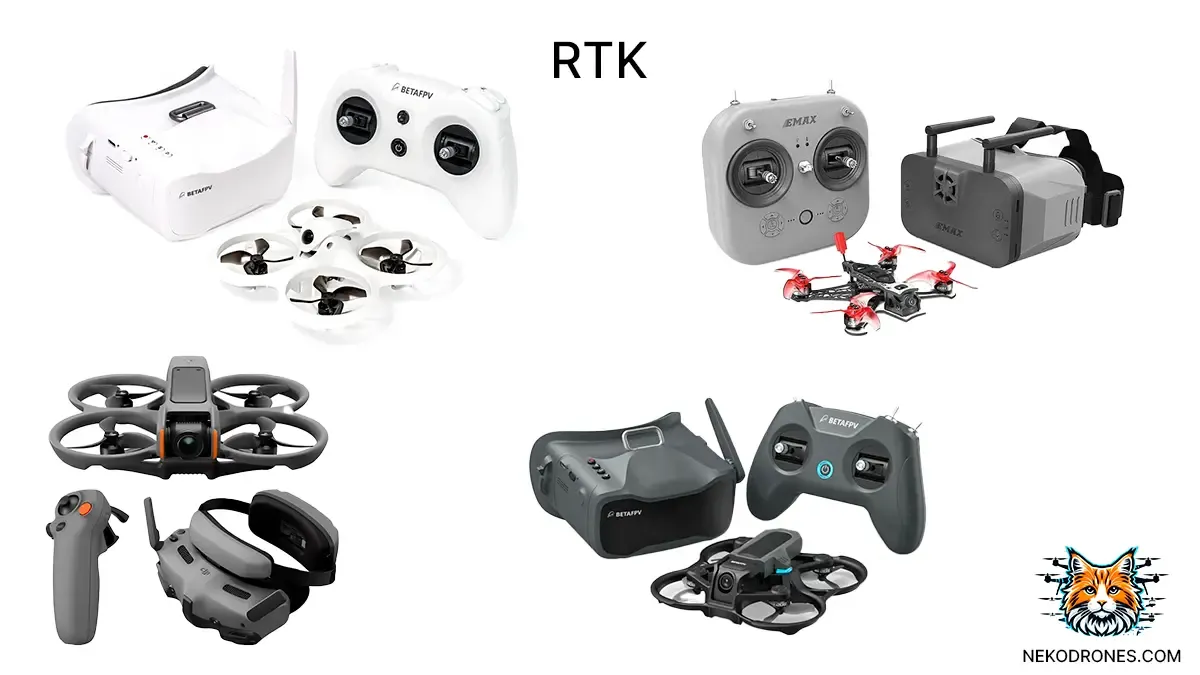 RTF kits are ideal for beginners who want to start flying FPV drones without the hassle of assembling components. These kits include everything needed to get started, such as the drone, transmitter, FPV goggles, batteries, and charger.
RTF kits are ideal for beginners who want to start flying FPV drones without the hassle of assembling components. These kits include everything needed to get started, such as the drone, transmitter, FPV goggles, batteries, and charger.
Batteries for Drones: 1S to 6S
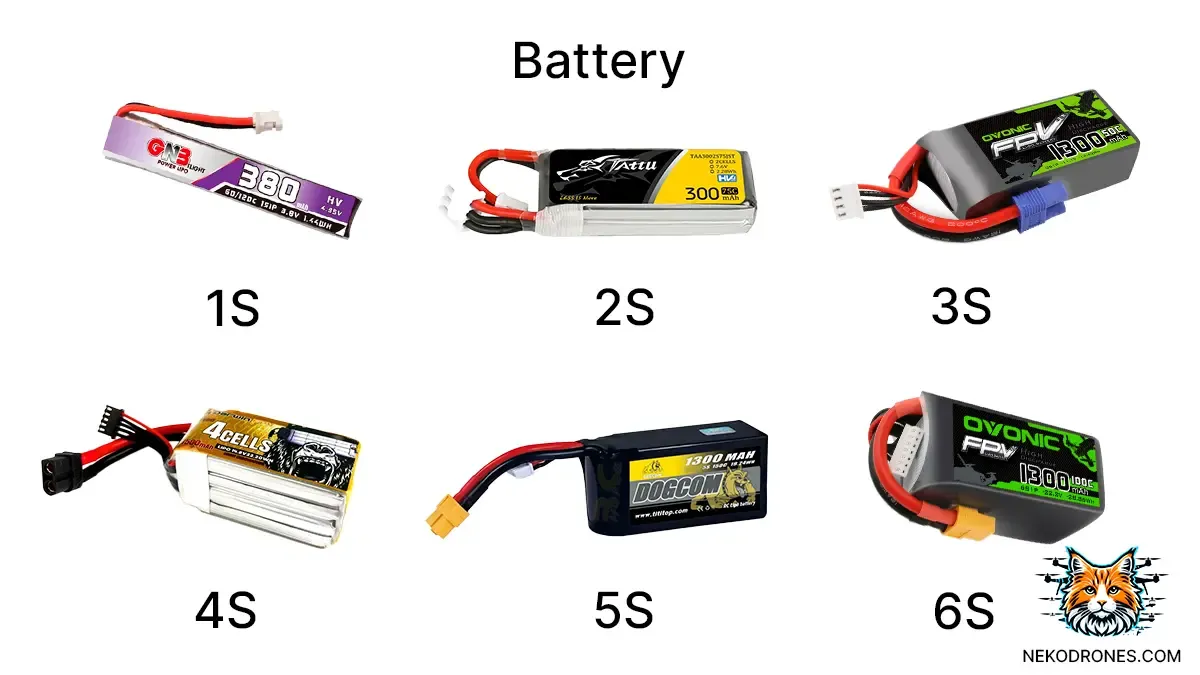
Battery Configurations and Uses
- 1S (3.7V): Used for very small, micro drones or indoor FPV drones.
- 2S (7.4V): Ideal for small to medium-sized drones, providing a balance between power and weight.
- 3S (11.1V): Commonly used in medium-sized drones, good power-to-weight ratio.
- 4S (14.8V): Popular for FPV racing and freestyle drones due to high power and agility.
- 5S (18.5V): Used in some high-performance racing and freestyle drones.
- 6S (22.2V): Employed in high-performance and professional setups.
Chargers and Charging
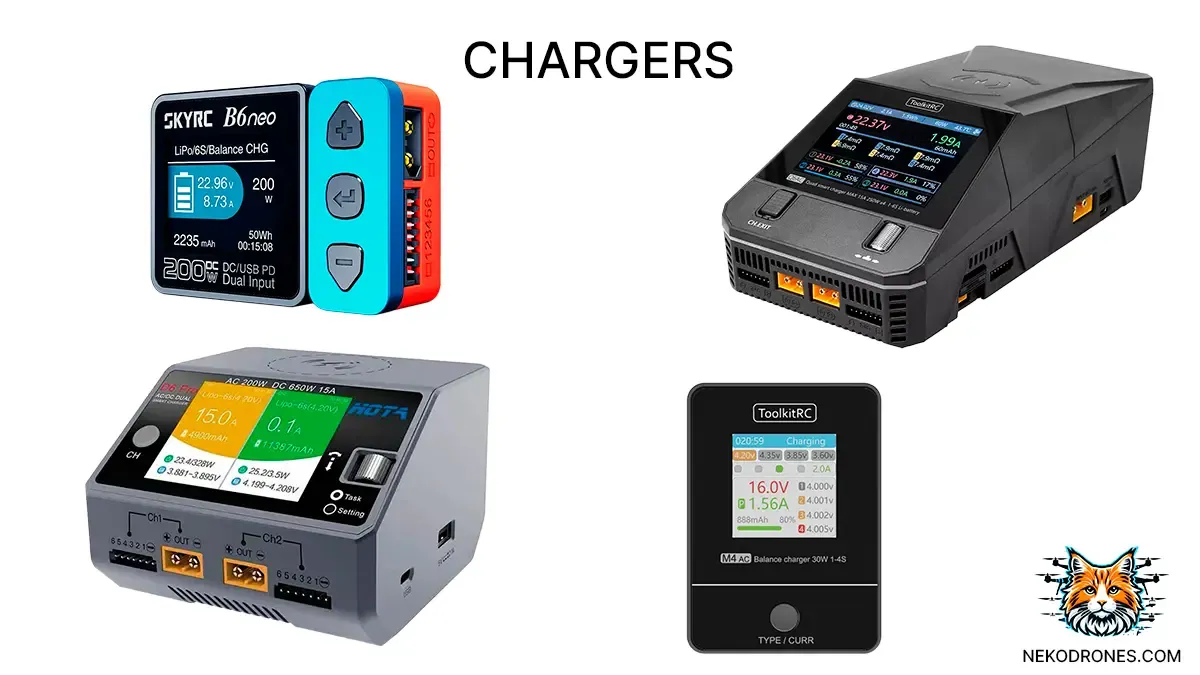
- Balance Chargers: Essential for charging LiPo batteries (1S to 6S).
- Voltage and Amperage Settings: Set the charger to match the battery’s specifications.
- Multi-Chargers: Useful for charging multiple batteries at once.
Key Considerations for Battery Management
- Charging Safety: Always use a balance charger and follow manufacturer guidelines.
- Storage Voltage: Store LiPo batteries at around 3.7V per cell to prolong their lifespan.
- Discharge Limits: Avoid discharging below 3.3V per cell.
- Temperature Management: Charge and store batteries at room temperature.
- Physical Damage: Regularly inspect batteries for any signs of swelling or damage.
Action Cameras Commonly Used with FPV Drones
Popular Action Cameras
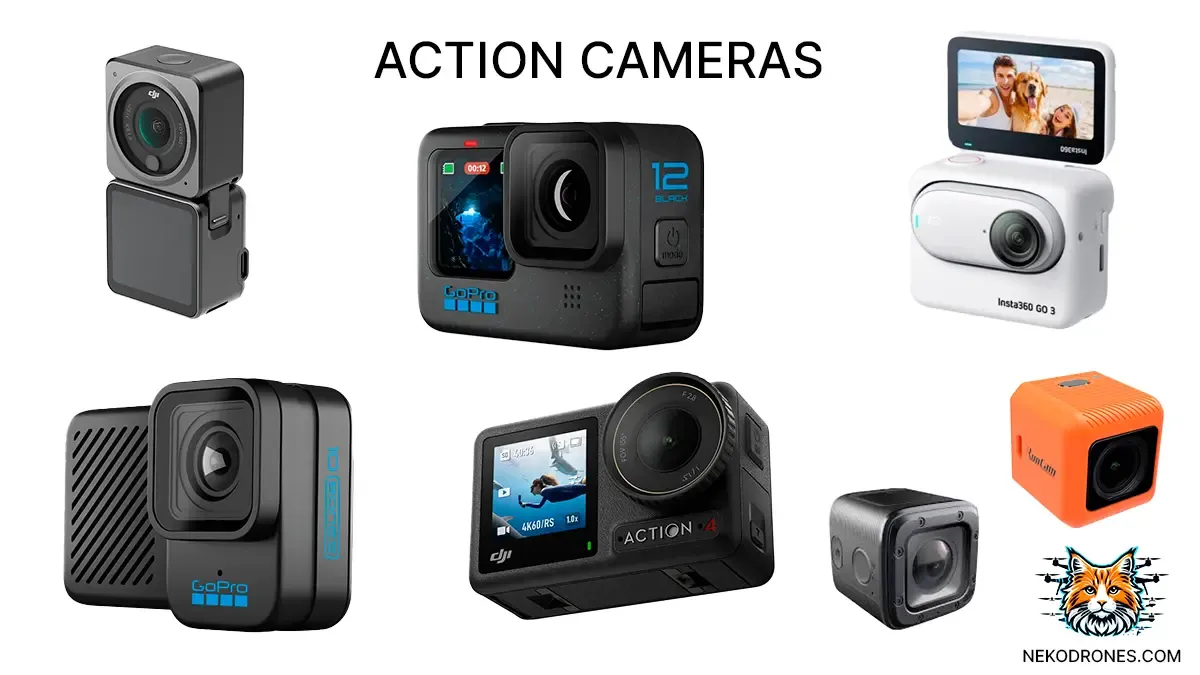
- GoPro
- Models: Hero 10, Hero 11, Hero 12, GoPro Bones
- Features: Excellent video quality, advanced stabilization, robust build.
- Usage: Preferred for cinematic FPV footage and professional videography.
- DJI Osmo Action
- Models: DJI Action 2, DJI Action 4
- Features: 4K video recording, RockSteady stabilization, dual screens.
- Usage: Great for capturing smooth and stable videos.
- Insta360 GO
- Models: Insta360 GO 3, Insta360 GO 3S
- Features: Ultra-lightweight, compact, built-in stabilization.
- Usage: Suitable for lightweight setups and tight spaces.
- Runcam and Foxeer Cameras
- Models: Runcam 5, Foxeer Box 2
- Features: 4K recording, good stabilization, rugged design.
- Usage: Popular among FPV enthusiasts for durability and ease of integration.
Key Considerations
- Video Quality: Higher resolution and frame rates provide better video quality.
- Stabilization: Built-in stabilization features help produce smooth footage.
- Weight and Size: Smaller and lighter cameras are preferred.
- Durability: Action cameras need to be robust to withstand crashes and harsh conditions.
Learning to Fly FPV Drones
Simulators
 Start with FPV simulators to build basic skills and muscle memory without risking real-world crashes. Recommended simulators include:
Start with FPV simulators to build basic skills and muscle memory without risking real-world crashes. Recommended simulators include:
- Liftoff, Liftoff Micro Drones: Great for high-end PCs, realistic physics.
- Uncrashed: Another high-quality simulator for powerful computers.
- Velocidrone: Suitable for lower-spec PCs, excellent tutorials for beginners.
- Tryp FPV: Provides a good balance of realism and accessibility.
Acro Mode
Learn Acro mode for full control. Avoid auto-level modes to develop better flying skills.
How to Tune FPV Drone
Use Blackbox for data-driven tuning or manually adjust PID settings for performance optimization.
Conclusion
FPV drone flying offers a thrilling and immersive experience, combining technical skills with the excitement of flight. Start with simulators, seek advice from the community, and enjoy the journey of mastering FPV drones.
FAQ
How High Can Drones Fly?
Most countries impose a height limit of 120 meters (400ft) for recreational RC models.
What is the Maximum Speed of an FPV Drone?
A typical 5-inch FPV drone can reach speeds up to 100 km/h or higher.
How Long Can FPV Drones Fly?
Flight times vary, but most FPV drones have a flight time of 5-10 minutes, depending on battery capacity and flying style.
Do I Need a License to Fly an FPV Drone?
In many countries, you need to register your drone and obtain a certification or license, especially if it's used for commercial purposes.
What Equipment Do I Need for FPV Flying?
Basic FPV equipment includes an FPV drone, remote controller, FPV goggles, batteries, a battery charger, and spare parts.
How Do I Maintain My FPV Drone?
Regularly check and tighten screws, inspect motors and propellers for damage, clean the drone after flights, and update firmware as needed.
Can FPV Drones Fly in the Rain?
It's generally not recommended to fly FPV drones in the rain as moisture can damage the electronics and motors.
What Are the Best Practices for Safe FPV Flying?
Always fly in open areas away from people and property, respect local regulations, maintain visual line of sight, and check your equipment before each flight.